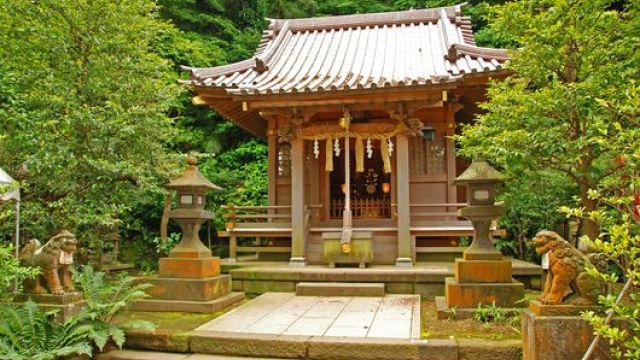
In the heart of Japan, where the ancient meets the modern, a world of tranquility and spirituality unfolds. Shinto shrines dot the landscape, each a testament to the country’s rich cultural heritage and deep-rooted beliefs. These sacred spaces invite visitors to pause and reflect, offering a glimpse into the harmonious relationship between nature, the divine, and humanity.
With their vibrant torii gates and serene gardens, shinto shrines in japan are more than just places of worship; they are living expressions of the Shinto faith, which emphasizes the connection with kami, the spirits of the natural world. As one wanders through the serene paths of these shrines, the whispers of the ancients echo through the rustling leaves, beckoning all to discover the enchantment that lies within.
Historical Significance
The historical significance of Shinto shrines in Japan is deeply rooted in the nation’s cultural and spiritual heritage. These shrines, known as "jinja," serve as the primary places of worship for the Shinto religion, which is considered the indigenous faith of Japan. They have been integral to the country’s narrative for centuries, tracing back to the earliest periods of Japanese history. Each shrine not only represents the divine presence of kami, the spirits worshipped in Shinto, but also reflects the unique regional traditions and historical events that shaped its existence.
Throughout the ages, Shinto shrines have been sites of important rituals and festivals that celebrate the changing seasons, agricultural success, and ancestral reverence. The construction of shrines often coincided with significant historical moments, such as the unification of Japan under imperial rule. Many of these sites were built to honor specific kami associated with nature, community, and national identity. As historical landmarks, they provide insight into Japan’s shifting cultural landscape and the interactions between Shinto and other influences, including Buddhism and Confucianism.
Moreover, the preservation of ancient practices and architectural styles within these shrines fosters a sense of continuity in Japanese history. From the distinctive design of torii gates marking the entrance to sacred spaces to the intricate rituals performed by priests, each element is imbued with meaning. This commitment to maintaining tradition is not just about honoring the past but also about fostering a communal identity that links contemporary society to its spiritual roots. Thus, Shinto shrines are more than just places of worship; they are a testament to Japan’s enduring heritage and cultural resilience.
Architectural Wonders
Shinto shrines in Japan are celebrated not just for their spiritual significance but also for their unique architectural styles that reflect the beauty of nature and traditional Japanese craftsmanship. The most recognizable feature of these shrines is the torii gate, which marks the transition from the profane to the sacred. Crafted from wood or stone, these gates often depict a minimalist elegance that captures the eye and invites visitors into a serene space. The use of natural materials harmonizes with the surroundings, embodying the Shinto belief that divinity exists in nature.
神社
The main shrine building, or honden, is often elevated on a platform and showcases a style that varies by region. Some shrines feature thatched roofs made from rice straw, while others adopt the use of intricate wooden joinery, demonstrating the high level of craftsmanship involved in their construction. The architectural designs are not merely aesthetic; they serve a practical purpose, allowing for ventilation and protection against the elements. Each detail, from the roof angle to the choice of materials, is carefully considered to enhance the spiritual experience of the site.
Moreover, the layout of Shinto shrines in Japan often incorporates a series of sacred spaces, leading visitors through a journey of discovery. Approaching the shrine, one encounters a path adorned with stones and trees, guiding them to the inner sanctum. The intentional placement of these elements fosters a sense of tranquility and connection to nature. The architectural wonders of these shrines do more than shelter the divine; they evoke a profound sense of peace and continuity with Japan’s ancient traditions.
Spiritual Practices
At the heart of Shinto shrines in Japan lies a range of spiritual practices that connect individuals to the divine. Visitors often begin their experience by participating in a ritual cleansing at the temizuya, a water basin where they wash their hands and mouth. This act signifies purification, preparing oneself to approach the kami, the deities that inhabit these sacred spaces. Engaging in these rituals deepens one’s appreciation for the spirituality that permeates the atmosphere of the shrine.
Offering gratitude and requests to the kami is another vital aspect of the spiritual experience at Shinto shrines. Many visitors write their wishes or prayers on small wooden plaques known as ema, which are then hung up as offerings. This practice reflects a deep-rooted belief in the kami’s ability to influence daily life, providing comfort and guidance. Each ema carries personal hopes, encompassing everything from health and happiness to success in studies and relationships.
Festivals and seasonal celebrations are integral to the spiritual life surrounding Shinto shrines. These events, known as matsuri, often involve traditional rituals, music, and dance, uniting the community in reverence for the kami. Each shrine has its own unique celebrations, showcasing the rich tapestry of local traditions and connecting the physical realm with the spiritual. Such vibrant festivities provide a lively expression of faith, fostering connection among the participants and with the divine.
Cultural Festivals
Shinto shrines in Japan are vibrant hubs of cultural celebration, hosting numerous festivals throughout the year. These festivals, or matsuri, are deeply rooted in tradition and reflect the rich spiritual heritage of Shinto practices. Locals and visitors alike gather to partake in the festivities, which often include colorful parades, traditional performances, and various community activities. Each shrine has its unique festivals, marking important seasonal changes, agricultural cycles, and honoring specific deities.
One of the most famous festivals associated with Shinto shrines is the Gion Matsuri in Kyoto, celebrated every July. This spectacular event features elaborate floats known as yamaboko, which parade through the streets, adorned with intricate designs and decorations. The festival not only celebrates the local deity of Yasaka Shrine but also fosters a sense of community and pride among the residents. The festivities create a lively atmosphere, with street vendors, traditional music, and dancers enhancing the experience for all.
Another significant celebration is the Nagasaki Kunchi, held each October at the Suwa Shrine. This vibrant festival showcases the unique cultural amalgamation of the region, featuring performances that represent Nagasaki’s maritime history and overseas influences. The highlight includes the stunning display of portable shrines, known as mikoshi, as they are carried through the streets in a colorful procession. These festivals serve as a profound reminder of the enduring relationship between the people and their spiritual beliefs, underscoring the enchantment of Shinto shrines in Japan.


